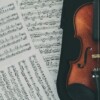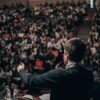Stratford Caldecott’s finely-written book, Beauty for Truth’s Sake, advocates a return to (Christian) Pythagoreanism as the founding spirit of liberal arts education. Caldecott understands true education as centered on the liberal arts, which he interprets in the spirit of their classical roots as trivium and quadrivium. He argues that education has been disenchanted, because it moved away from the holistic spirit that animated the liberal arts. Thus, he aims to re-enchant education by returning to the path of true wisdom which, he argues, is the Pythagorean spirit. This central root of Western civilization Caldecott identifies with the ancient idea of cosmic order, Logos. Infusing education with this spirit, he contends, will give students the ability to perceive inner connecting principles and inherent relations of creation as Logos.
The book has six chapters. In chapter 1 he describes the four parts of the quadrivium—arithmetic, geometry, music, astronomy—including particularly their roots in Greek and medieval traditions of education. He argues that these subjects are irreplaceable for transmitting civilized thought and behavior from generation to generation; this task requires retrieving the ancient cosmology that grounded them, namely, Christian Pythagoreanism. Chapter 2 dovetails with this framework by retrieving a different way of thinking, one that involves an appreciation of symbolism and beauty. This is poetic imagination, something he connects with symbolism and the idea of cosmos.
The next three chapters describe more directly the Pythagorean spirit he wishes to retrieve. In chapter 3 Caldecott presents a primer in Pythagorean wisdom, including an explanation of the sacred dimension of numbers, which he presents as their symbolic associations. In chapter 4 Caldecott connects the previous chapter’s recovery of the symbolic associations to theology. For example, he finds the mark of the Trinity in the mathematical and geometrical relations among numbers. He expands this recovery in chapter 5 by delving into the areas of music, architecture, and (geometric) planetary relations, which are meant to show how cosmology leads us to theology. The three chapters are meant to present the Pythagorean spirit that ought to animate and ground the liberal arts, so that education can be re-enchanted.
Chapter 6 situates the previous three chapters more directly into education. The idea of liturgy, including particularly a renewed sense of the sacred, via especially the notion of beauty, is the vehicle for this entry. It is through liturgy that the original (Christian Pythagorean) spirit of the liberal arts can be recovered, gaining the beauty of the cosmos in its harmony and symbolism for the liberal arts. This recovery will then aid education in bringing us back to our true humanity.
This is a clearly written book. Although it traverses a wide range of topics, many technical, it is very accessible. Caldecott is a master at taking complex ideas and synthesizing them into understandable presentations. And he makes a clear case for the importance of re-enchanting the liberal arts with a Christian Pythagorean spirit.
However, the book also has considerable drawbacks. Some might well have to do with the fact that this is a very short book with an ambitious task. This is perhaps the reason why Caldecott presents the Pythagorean beliefs in sanitized fashion, picking out the features that might be most germane to his sense of cosmic order while leaving behind their more problematic connection to a pantheon of gods and divine, pagan forces. It might also be the reason why he lumps together those whom he opposes. For example, he groups structuralists, postmodernists, and deconstructionists, although these are strikingly different. Structuralists, such as Claude Levi-Strauss, attempt to develop a scientific and objective approachto their object of study—the opposite of Caldecott’s depiction. Conversely, deconstructionists, such as Jacques Derrida, recognize the difficulty of scientific attempts to achieve objective truth, but nevertheless steadfastly refuse the label of postmodern, instead claiming central tenets of the Enlightenment. And postmodernists, such as Jean-Francois Lyotard, have an aversion to the grand narratives of reason and progress as spun by the Enlightenment. Thus, these three are quite different—yet Caldicott does not differentiate among them. Ironically, in the particularities of their differences Caldecott could find allies as opponents for his project just as easily.
A similar drawback appears in his discussion of humane architecture. Caldecott depicts modern skyscrapers as machines designed for efficient horizontal motion, contrasting them with the architecture of medieval cathedrals. His focus is a set of correspondences between humans and nature which constitute the harmony of creation. But in the process he seems to lump together all current architecture as modern. Thus, he does not differentiate between pre-modern skyscrapers such as the Hobert Building in San Francisco or New York’s Liberty Tower and more typically modernist architecture such as the Lever House in New York City or the Sears Tower in Chicago, let alone Tschumi’s decidedly anti-functionalist approach. Itis difficult to lump all of these together as modernist and thus indict them as “drab and ugly”(98) and inhumane. Although Caldecott has an arguable point, it is dulled by generalizations that do not stand up to further examination. Furthermore, he could have made his pointmore forcefully had he used a more finely-tuned analysis, in part because certain current examples of architecture could have been marshaled to support his overall critique of modernist buildings.
A more basic drawback is his call to re-enchant education through a return to Pythagorean wisdom. What is it about Pythagorean mysteries that privilege them for re-enchantment? In his book A Secular Age, Charles Taylor gives an account of the enchanted world in the medieval period, which includes a myriad of earthly powers for both good and evil. The world was enchanted because, according to Taylor, these were thought to affect humans directly and thus also required (collective) human action to maintain good and ward off evil. Caldecott mentions little of this enchantedness, although his book advocates a re-enchantment of education. Thus his argument for its re-enchantment is incomplete at best, for it ignores the good work of modernity to overcome these more problematic forms of enchantment. He provides no argument about why we ought to reject those forms of enchantment in his embrace of Pythagoras.
Another weakness is his embrace of symbols—the symbolism associated with numbers that Caldecott garners in support of his Christian Pythagoreanism is not convincing. For example, he argues that 1 times 1 divided by 1 is a description of the Trinity. I would agree that this is an interesting heuristic device employing characteristics of the number 1 to help explain the mystery of the Trinity, but it seems forced to conclude that that this is the mark of the Trinity in the domain of numbers. He has reversed the order, for his presentation is actually an explication of the Trinity with the aid of the number 1, rather than a discovery of the Trinity in the properties of that number. Similarly, Caldecott uses geometrical diagrams and relationships to describe the Christian Trinity. Again, this certainly is perfectly fine as an explanatory device to make sense of something as ineffable and dynamic as the Trinity, but it does not show the mark of the Trinity in geometry. Caldecott has reversed the order. It is not because the mathematical or geometrical relations are somehow deeply marked by the Trinity, but because these are handy mathematical models for understanding the latter. He has not so much uncovered the archetypal forms of the Trinity as projected interesting relations in mathematics and geometry onto theological concepts to help illuminate the latter.
There is a final worry that needs to be mentioned. Reinfusing the Pythagorean spirit into the liberal arts in order to rediscover our true humanity problematically falls into the very dualism that Caldecott seeks to overcome. Although he accuses current education as exemplifying “a way of thinking and living that is dualistic in character” (12), his own solution actually ignores the embodied character of students and teachers. His approach seemsto require students to be immaterial souls that can be enthused by the spirit of Pythagoras generically, leaving aside their materiality—and hence, ignoring their gender, race, language, sexual orientation, culture, and social position. This allows him, for example, (despite an early caveat in a footnote) to use gender-exclusive language, making it appear as if females do not exist in the cosmos. And it allows him to make invisible issues of social injustice, as if actual schools do not have inequities or that societies are not burdened by issues of social justice. And his description of creation as mathematical harmonies allows him to ignore the groaning of creation under the burden of environmental problems such as global climate change. These are all issues of materiality. One might expect that an approach meant to overcome dualistic thinking would broach these aspects of materiality. But Caldecott is silent on these, focusing exclusively on the other half of the dualism, the spiritual.
Overall, Caldecott’s book is worth reading for those interested in the discussion of the historical, spiritual meaning of the liberal arts, especially within the context of Christianity. But I am not convinced that it provides an adequate antidote for current issues facing education and society. Even for liberal arts institutions of higher education that are religious and church-affiliated, his book’s message does not speak adequately to the complexity of making the liberal arts relevant for the twenty-first century in addressing its increasingly globalizing issues and problems. Liberal arts education infused with a Christian spirit ought to connect more concretely with the materiality of our earthly existence.























